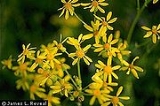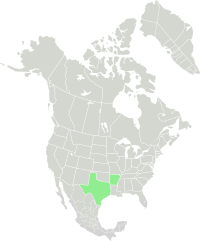
Senecio ampullaceus
Encyclopedia
Senecio ampullaceus also known as Texas ragwort, Texas squaw-weed, Texas groundsel,
and Texas butterweed
is a species of Senecio
in the family Asteraceae
and gets its Latin name ampullaceus from its flask shaped flower-head
and is a recommended native for landscape use in Texas
where it came from.
growing to from 20 centimetres (7.9 in) to 80 centimetres (31.5 in) tall and similar to S. quaylei.
Stems and leaves:
The leaves with broadly winged leaf stalks, grow from single stems; the nodes between leaves getting shorter and shorter higher on the stem. Ovate leaves with pointed tips 3 centimetres (1.2 in) to 10 centimetres (3.9 in) long by 1.5 centimetre (0.590551181102362 in) to 4 centimetres (1.6 in) wide with tapered bases. Leaves at the lower portion of the plant have more teeth on their edges than the leaves at the upper portion of the mature plant.
Stems and leaves are covered loosely and unevenly with a mat of fine hairs, occasionally having no hairs.
Flowers:
Flowering stalks have 10 to 30 flower heads which as a group make a flat top to the whole plant. Each flower head is surrounded by 2 to 8 bractlets or mini-leaves, each 1 millimetre (0.0393700787401575 in) to more than 2 millimetre (0.078740157480315 in). Approximately 13 green to grayish bracts, 7 millimetre (0.275590551181102 in) to 10 millimetre (0.393700787401575 in) long surrounding 8 ray florets and an 8 millimetre (0.31496062992126 in) to 10 millimetre (0.393700787401575 in) corolla.
Fruits:
One seeded fruits with rigid pappus
.
Roots:
Roots relatively thin and branching.
Native:

or
Current:
and Texas butterweed
is a species of Senecio
Senecio
Senecio is a genus of the daisy family that includes ragworts and groundsels. The flower heads are normally rayed, completely yellow, and the heads are borne in branched clusters...
in the family Asteraceae
Asteraceae
The Asteraceae or Compositae , is an exceedingly large and widespread family of vascular plants. The group has more than 22,750 currently accepted species, spread across 1620 genera and 12 subfamilies...
and gets its Latin name ampullaceus from its flask shaped flower-head
and is a recommended native for landscape use in Texas
Texas
Texas is the second largest U.S. state by both area and population, and the largest state by area in the contiguous United States.The name, based on the Caddo word "Tejas" meaning "friends" or "allies", was applied by the Spanish to the Caddo themselves and to the region of their settlement in...
where it came from.
Description
The seedlings of S. ampullaceus often have a purplish color on the undersides of their leaves in the winter, especially along their midrib. Flowering in early–mid spring, Texas ragwort is a tall annual,growing to from 20 centimetres (7.9 in) to 80 centimetres (31.5 in) tall and similar to S. quaylei.
Stems and leaves:
The leaves with broadly winged leaf stalks, grow from single stems; the nodes between leaves getting shorter and shorter higher on the stem. Ovate leaves with pointed tips 3 centimetres (1.2 in) to 10 centimetres (3.9 in) long by 1.5 centimetre (0.590551181102362 in) to 4 centimetres (1.6 in) wide with tapered bases. Leaves at the lower portion of the plant have more teeth on their edges than the leaves at the upper portion of the mature plant.
Stems and leaves are covered loosely and unevenly with a mat of fine hairs, occasionally having no hairs.
Flowers:
Flowering stalks have 10 to 30 flower heads which as a group make a flat top to the whole plant. Each flower head is surrounded by 2 to 8 bractlets or mini-leaves, each 1 millimetre (0.0393700787401575 in) to more than 2 millimetre (0.078740157480315 in). Approximately 13 green to grayish bracts, 7 millimetre (0.275590551181102 in) to 10 millimetre (0.393700787401575 in) long surrounding 8 ray florets and an 8 millimetre (0.31496062992126 in) to 10 millimetre (0.393700787401575 in) corolla.
Fruits:
One seeded fruits with rigid pappus
Pappus (flower structure)
The pappus is the modified calyx, the part of an individual disk, ray or ligule floret surrounding the base of the corolla, in flower heads of the plant family Asteraceae. The pappus may be composed of bristles , awns, scales, or may be absent. In some species, the pappus is too small to see...
.
Roots:
Roots relatively thin and branching.
Distribution
S. ampullanceus prefers altitudes of 100 metres (328.1 ft) to 800 metres (2,624.7 ft) in open sandy or disturbed sites.Native:

- NearcticNearcticThe Nearctic is one of the eight terrestrial ecozones dividing the Earth's land surface.The Nearctic ecozone covers most of North America, including Greenland and the highlands of Mexico...
:- North-central United States: MissouriMissouriMissouri is a US state located in the Midwestern United States, bordered by Iowa, Illinois, Kentucky, Tennessee, Arkansas, Oklahoma, Kansas and Nebraska. With a 2010 population of 5,988,927, Missouri is the 18th most populous state in the nation and the fifth most populous in the Midwest. It...
- Southeastern United States: ArkansasArkansasArkansas is a state located in the southern region of the United States. Its name is an Algonquian name of the Quapaw Indians. Arkansas shares borders with six states , and its eastern border is largely defined by the Mississippi River...
- South-central United States: TexasTexasTexas is the second largest U.S. state by both area and population, and the largest state by area in the contiguous United States.The name, based on the Caddo word "Tejas" meaning "friends" or "allies", was applied by the Spanish to the Caddo themselves and to the region of their settlement in...
- North-central United States: Missouri
or
-
- Southeastern United States: ArkansasArkansasArkansas is a state located in the southern region of the United States. Its name is an Algonquian name of the Quapaw Indians. Arkansas shares borders with six states , and its eastern border is largely defined by the Mississippi River...
- South central United States: TexasTexasTexas is the second largest U.S. state by both area and population, and the largest state by area in the contiguous United States.The name, based on the Caddo word "Tejas" meaning "friends" or "allies", was applied by the Spanish to the Caddo themselves and to the region of their settlement in...
- Southeastern United States: Arkansas
Current:
- NearcticNearcticThe Nearctic is one of the eight terrestrial ecozones dividing the Earth's land surface.The Nearctic ecozone covers most of North America, including Greenland and the highlands of Mexico...
:- North-central United States: MissouriMissouriMissouri is a US state located in the Midwestern United States, bordered by Iowa, Illinois, Kentucky, Tennessee, Arkansas, Oklahoma, Kansas and Nebraska. With a 2010 population of 5,988,927, Missouri is the 18th most populous state in the nation and the fifth most populous in the Midwest. It...
, OklahomaOklahomaOklahoma is a state located in the South Central region of the United States of America. With an estimated 3,751,351 residents as of the 2010 census and a land area of 68,667 square miles , Oklahoma is the 28th most populous and 20th-largest state... - Southeastern United States: ArkansasArkansasArkansas is a state located in the southern region of the United States. Its name is an Algonquian name of the Quapaw Indians. Arkansas shares borders with six states , and its eastern border is largely defined by the Mississippi River...
- South-central United States: TexasTexasTexas is the second largest U.S. state by both area and population, and the largest state by area in the contiguous United States.The name, based on the Caddo word "Tejas" meaning "friends" or "allies", was applied by the Spanish to the Caddo themselves and to the region of their settlement in...
- North-central United States: Missouri
Varieties or subspecies which are synonyms
- Senecio ampullaceus var. floccosus Engelm. & A. Gray
- Senecio ampullaceus var. glaberrimus Engelm. & A. Gray

